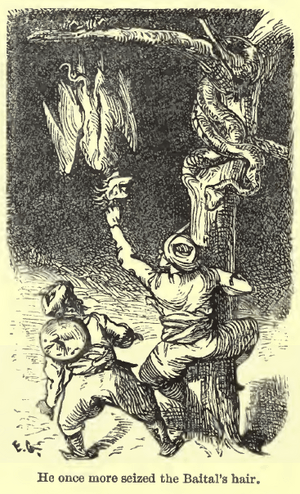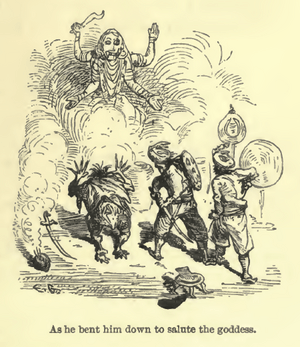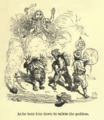Baital Pachisi facts for kids
Vetala Panchavimshati (which means "Twenty-five (tales) of the Vetala") is a very old collection of stories from India. It's also known around the world as Vikram-Betaal. These tales were first written in Sanskrit, an ancient Indian language.
One of the oldest versions of these stories can be found in a huge Sanskrit book called Kathasaritsagara. This book was put together in the 11th century by a writer named Somadeva. However, the stories themselves are even older than that! The Kathasaritsagara version actually has twenty-four tales, with the main story of King Vikram and the Vetala being the twenty-fifth.
The Vetala stories are very popular in India. They have been translated into many different Indian languages, like Hindi, Tamil, Bengali, and Marathi. There are also several English versions. One of the most famous English versions was written by Sir Richard Francis Burton. His version is not a direct translation, but a fun retelling of the tales.
The Main Story
The stories are about a brave and wise king named Vikramaditya (also called Vikrama). He makes a promise to a tantric sorcerer. This sorcerer wants King Vikrama to capture a vetala. A vetala is a special spirit that can live inside dead bodies. It often hangs upside-down from trees, a bit like a vampire in Western stories.
King Vikrama faces many challenges trying to bring the vetala to the sorcerer. Every time Vikrama catches the vetala, the spirit tells him a story. Each story ends with a difficult riddle.
- If King Vikrama cannot answer the riddle correctly, the vetala will stay captured.
- If the king knows the answer but stays silent, his head will explode into a thousand pieces!
- But if King Vikrama answers the question correctly, the clever vetala escapes and flies back to its tree.
King Vikrama is very smart and knows the answer to every question. So, he keeps catching the vetala, answering its riddles, and then watching it escape. This happens twenty-four times!
On the twenty-fifth try, the Vetala tells a very confusing story. It's about a father and a son who survive a terrible war. They find a queen and a princess alive and decide to take them home. Later, the son marries the queen, and the father marries the princess. Eventually, the son and the queen have a son, and the father and the princess have a daughter. The vetala then asks King Vikrama: "What is the relationship between these two newborn children?"
This question finally stumps King Vikrama! He doesn't know the answer. Because he couldn't answer, the vetala allows itself to be taken to the sorcerer.
On their way to the sorcerer, the Vetala tells King Vikrama its own story. The Vetala explains that its parents were blessed with twin sons by a tantric, but only if both sons were taught by him. The Vetala was taught everything but treated badly, while its brother was treated well. The Vetala found out that the tantric planned to sacrifice it because it was "all-knowing." By sacrificing the Vetala, the tantric would become immortal and rule the world with his magic.
The Vetala then reveals the sorcerer's evil plan for King Vikrama. The sorcerer plans to trick Vikrama into bowing before a goddess, then behead him. This would allow the sorcerer to control the Vetala and sacrifice its soul, making his evil dream come true. The Vetala gives King Vikrama a clever idea: ask the sorcerer how to bow correctly. When the sorcerer demonstrates, Vikrama should quickly behead him instead.
King Vikramaditya does exactly what the Vetala suggests! He defeats the evil sorcerer. Because of his wisdom and bravery, Lord Indra and Devi Kali bless him. The Vetala then offers King Vikrama a wish. King Vikrama wishes for the sorcerer's heart and mind to be cleaned of all badness, and for his life to be restored as a good person. He also asks that the Vetala come to his aid whenever he needs help.
Vikram-Betaal in Movies and TV
The exciting stories of Vikram and Betaal have been made into many movies and TV shows over the years!
Films
- In 1951, a Hindi film called Jai Maha Kali (Vikram Vaital) was made.
- It was remade in 1986 as Vikram Vetal.
- In 2017, a Tamil film called Vikram Vedha was a modern version of the story. The main characters in the film were inspired by King Vikramaditya and the Vetala.
Television
- In 1985, a very popular TV show called Vikram aur Betaal was made by Sagar Films. It starred Arun Govil as King Vikrama and Sajjan Kumar as the Vetala. It was shown on Doordarshan, India's public TV channel.
- A newer version of that show, called Kahaniyaan Vikram aur Betaal Ki, was aired on Colors.
- Indian animator Rajiv Chilaka directed a TV movie called Vikram Betal for Cartoon Network in 2004.
- A supernatural comedy show from 2006, Vicky & Vetaal, was also inspired by these tales.
- In 2009, a web series called The Vetala was released.
- In 2018, a Hindi TV show called Vikram Betaal Ki Rahasya Gatha was aired on &TV.
Literature
- The children's magazine Chandamama used to feature a serial story called New Tales of Vikram and Betal for many years. These stories kept the original idea of the Vetala telling new tales to King Vikrama.
- In the novel Alif the Unseen, there's a character named Vikrama the Vampire. He tells how King Vikrama once fought a vampire spirit called the Vetala. King Vikrama won the Vetala's game of wits, but then gave up his own life. Now, the Vetala lives inside his body.
Images for kids







